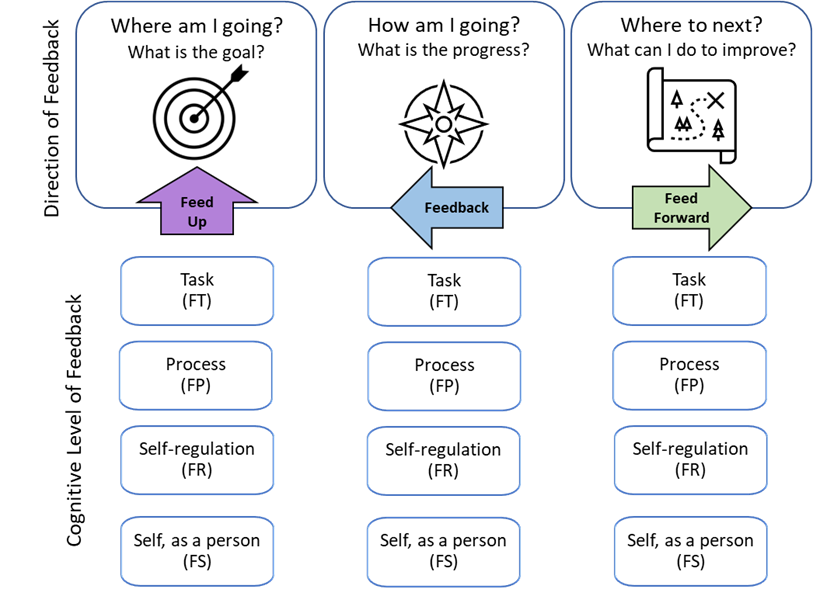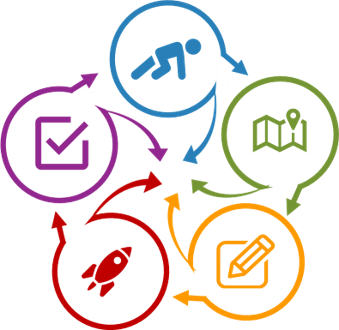A few months ago, I wrote about the direction of feedback – Feed up, back, and forward (available here). In addition to direction, when we write feedback we should consider what Hattie & Timperley (2007) refer to as the cognitive level of the feedback. They describe 4 types of cognitive levels: Task (FT), Process (FP), Self-regulation (FR), and Self, as a person (FS). These are defined as levels because providing feedback at a higher level than the student is ready for (or for which the student is ready) will not properly improve the student’s work. The most obvious example is providing Self (as a Person) feedback to someone who is not able to properly complete the task “Your doing great! I know you can do this own your own,” does nothing to support the student who does not know how to approach a math equation.
Why focus on formative feedback?
“Some see summative [feedback] as needing to be highly reliable but with formative, the measurement rigor can be less. If formative is more powerful, then it, too, needs to be based on highly valid measures and observations” (Hattie & Hamilton, 2020, p. 16).
Task Feedback (FT):
Definition:
This feedback focuses on the correctness, quality, and completeness of the assignment submission. It evaluates how well the task was performed and provides feedback on the results or product of the work.
Examples:
“You completed the task accurately.”
“The report is well-structured, but it lacks a clear conclusion.”
“The calculations are correct, but the explanation of the data could be clearer.”
Process Feedback (FP):
Moving from task to process level
When the student has successfully demonstrated an understanding of the task, you can move to process feedback – how to improve their approach to the task. This can help the student enhance their problem-solving and also foster their ability to self-check and self-correct.
Definition:
Process feedback focuses on the methods, strategies, and approaches used to complete the assignment. It provides guidance on how the assignment was approached and offers suggestions for improving the process or technique for future tasks.
Examples:
“The approach you took to analyze the data was effective, but next time consider breaking the problem down into smaller steps.”
“Try outlining your work first to help you organize your ideas before diving into the full task.”
“The method you used to gather information was efficient, but you might want to consider a few more sources for a more comprehensive view.”
Self-regulation Feedback (FR):
Moving from process to self-regulation level
Once the student has displayed ability to work independently or without frequent guidance, successfully demonstrated an understanding of the task, you can move to self-regulation feedback, providing students with the ability to adapt, set goals, and self-evaluate. This supports deeper learning and application of self-regulation habits to other assignments.
Definition:
This type of feedback targets the individual’s ability to manage, control, and adjust their own learning and performance. It helps the person reflect on their own behavior, emotions, and strategies for managing tasks and challenges.
Examples:
“You did a great job staying focused throughout the task. However, there were moments when you seemed to get frustrated. Consider taking short breaks to manage stress.”
“You showed good self-control by asking for help when needed. Keep practicing this self-awareness in future tasks.”
“Try setting specific goals for your study time to maintain better focus and motivation.”
Self (as a Person) Feedback (FS):
Moving from self-regulation to self as a person level
Self (as a Person) feedback is not just “you done good!” this is a level where you praise the students personal traits to encourage then to keep pushing themselves to improve. This can help foster self-motivation.
Definition:
This feedback focuses on the individual as a person, their attitudes, behaviors, and personal attributes. It can highlight qualities such as perseverance, attitude, and personal growth. It’s more holistic and looks at the overall characteristics of the individual beyond the task.
Examples:
“You demonstrated great perseverance and a positive attitude throughout the project.”
“You are highly creative, but sometimes your attention to detail could be improved.”
“Your collaborative skills are impressive but remember to involve everyone more evenly in discussions.”
The complete model

References
EL Takeaways: 7 Things to Remember About Feedback. (2012, September). Educational Leadership, 70(1), 96.
Hattie, J., & Hamilton, A. (2020). As Good as Gold? Why We Focus on the Wrong Drivers in Education. Corwin Press, Inc. https://www.visiblelearning.com/sites/default/files/as-good-as-gold-10.16.pdf
Hattie, J., & Timperley, H. (2007). The Power of Feedback. Review of Educational Research, 77(1), 81–112. https://doi.org/10.3102/003465430298487
